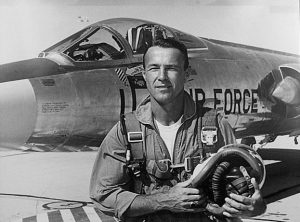6 December 1963: Air Force test pilot Major Robert W. Smith takes the Lockheed NF-104A Aerospace Trainer, 56-0756, out for a little spin. . .
Starting at 0.85 Mach and 35,000 feet (10,668 meters) over the Pacific Ocean west of Vandenberg Air Force Base, California, Bob Smith turned toward Edwards Air Force Base and accelerated to Military Power and then lit the afterburner, which increased the General Electric J79-GE-3B turbojet engine’s 9,800 pounds of thrust (43.59 kilonewtons) to 15,000 pounds (66.72 kilonewtons). The modified Starfighter accelerated in level flight. At Mach 2.2, Smith ignited the Rocketdyne LR121 rocket engine, which burned a mixture of JP-4 and hydrogen peroxide. The LR121 was throttleable and could produce from 3,000 to 6,000 pounds of thrust (13.35–26.69 kilonewtons).
When the AST reached Mach 2.5, Smith began a steady 3.5G pull-up until the interceptor was in a 70° climb. At 75,000 feet (22,860 meters), the test pilot shut off the afterburner to avoid exceeding the turbojet’s exhaust temperature (EGT) limits. He gradually reduced the jet engine power to idle by 85,000 feet (25,908 meters), then shut it off. Without the engine running, cabin pressurization was lost and the pilot’s A/P22S-2 full-pressure suit inflated.
The NF-104A continued to zoom to an altitude where its aerodynamic control surfaces were no longer functional. It had to be controlled by the reaction jets in the nose and wing tips. 756 reached a peak altitude of 120,800 feet (36,820 meters), before reentering the atmosphere in a 70° dive. Major Smith used the windmill effect of air rushing into the intakes to restart the jet engine.
Major Smith had set an unofficial record for altitude. Although Lockheed had paid the Fédération Aéronautique Internationale (FAI) license fee, the Air Force had not requested certification in advance so no FAI or National Aeronautic Association personnel were on site to certify the flight.
For this flight, Robert Smith was nominated for the Octave Chanute Award “for an outstanding contribution made by a pilot or test personnel to the advancement of the art, science, and technology of aeronautics.”
